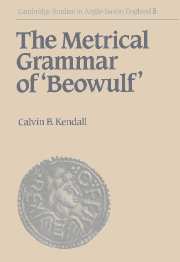Book contents
- Frontmatter
- Contents
- Preface
- List of abbreviations
- List of changes from Klaeber's text
- 1 The Beowulf-poet and his metrical grammar
- 2 The alliterative and metrical principles of Beowulf: Kuhn's ‘laws’ and the transformational rule
- 3 The three kinds of half-lines: extra-metrical alliteration and type A3
- 4 Displacement
- 5 Stressed proclitic adjectives: X-positions and the insertion rule
- 6 Problems with the identification of clause-non-initial half-lines: the proclitic onset
- 7 Half-lines with internal clause divisions: the transformational rule (revised)
- 8 The alliterative requirement of unstressed prefixes and the copulative conjunctions
- 9 The alliterative requirement of prepositions and the proclitic adverbs and instrumentals
- 10 The alliterative requirement of proclitic adjectives and pronouns: the alliterative rule of proclitics
- 11 Displaced and detached proclitics
- 12 The three classes of compounds: the alliterative requirement of class I compounds
- 13 The alliterative behaviour of class II compounds
- 14 The alliterative behaviour of class III compounds and simplexes
- 15 Metrical typology and the metrical grammar
- 16 Conclusions
- Appendix: A typology of the metre of Beowulf in relation to the metrical grammar
- Glossary of technical terms
- Bibliography
- Index of alliteration, scansion and metrical clause structure
- Index of verses specially discussed
10 - The alliterative requirement of proclitic adjectives and pronouns: the alliterative rule of proclitics
Published online by Cambridge University Press: 22 September 2009
- Frontmatter
- Contents
- Preface
- List of abbreviations
- List of changes from Klaeber's text
- 1 The Beowulf-poet and his metrical grammar
- 2 The alliterative and metrical principles of Beowulf: Kuhn's ‘laws’ and the transformational rule
- 3 The three kinds of half-lines: extra-metrical alliteration and type A3
- 4 Displacement
- 5 Stressed proclitic adjectives: X-positions and the insertion rule
- 6 Problems with the identification of clause-non-initial half-lines: the proclitic onset
- 7 Half-lines with internal clause divisions: the transformational rule (revised)
- 8 The alliterative requirement of unstressed prefixes and the copulative conjunctions
- 9 The alliterative requirement of prepositions and the proclitic adverbs and instrumentals
- 10 The alliterative requirement of proclitic adjectives and pronouns: the alliterative rule of proclitics
- 11 Displaced and detached proclitics
- 12 The three classes of compounds: the alliterative requirement of class I compounds
- 13 The alliterative behaviour of class II compounds
- 14 The alliterative behaviour of class III compounds and simplexes
- 15 Metrical typology and the metrical grammar
- 16 Conclusions
- Appendix: A typology of the metre of Beowulf in relation to the metrical grammar
- Glossary of technical terms
- Bibliography
- Index of alliteration, scansion and metrical clause structure
- Index of verses specially discussed
Summary
There are three kinds of proclitic adjectives and pronouns – (1) the possessives, (2) the indefinites and (3) the demonstratives and definite articles.
The possessives are the possessive pronouns (adjectives) min, pin, sin, uncer (incer does not occur as a possessive in Beowulf), ure, eower and the genitives his, hire, hira of the third person pronoun used possessively. The possessives of the first and second persons must be distinguished from the genitives of the personal pronouns which have the same forms (though never inflectional endings), but which are sentence particles rather than proclitics and are almost always emphatic. Likewise, the possessive genitives of the third person pronouns need to be distinguished from other non-possessivé genitives, though it is not always easy to do so.
The indefinites include the indefinite adjectives of quantity studied by Desmond Slay: ænig, eall, [fea], fela, monig, nænig and sum; together with genog, [lytel, læssa, læsest], micel, mara, mæst, nan and oðer. The forms in brackets are fully stressed adjectives.
The demonstratives and definite articles are swylc, pyslic and yica; se, seo, pæt and pes, peos, pis.
- Type
- Chapter
- Information
- The Metrical Grammar of Beowulf , pp. 131 - 145Publisher: Cambridge University PressPrint publication year: 1991



